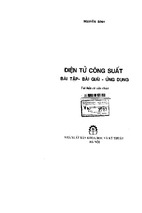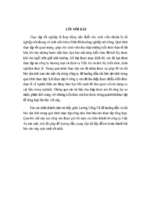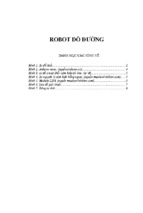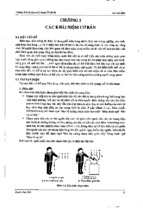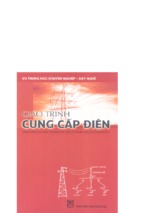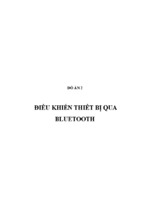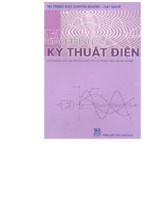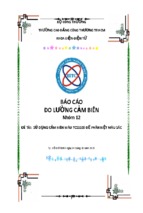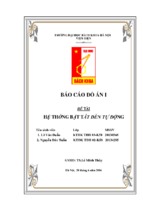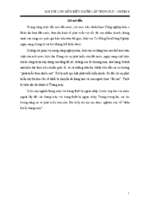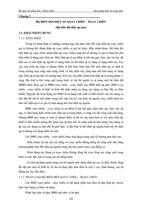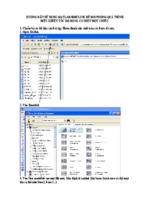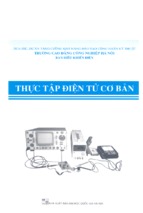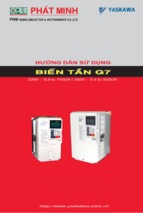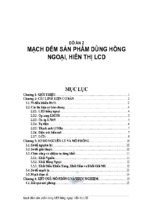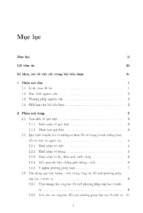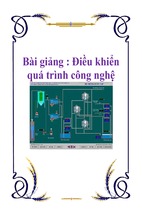The PID Control Algorithm
How it works, how to tune it, and
how to use it
2nd Edition
John A. Shaw
Process Control Solutions
December 1, 2003
Introduction
ii
John A. Shaw is a process control engineer and president of Process Control
Solutions. An engineering graduate of N. C. State University, he previously
worked for Duke Power Company in Charlotte, N. C. and for Taylor Instrument
Company (now part of ABB, Inc.) in, N. Y. Rochester He is the author of over 20
articles and papers and continues to live in Rochester.
Copyright 2003, John A. Shaw, All rights reserved. This work may not be resold,
either electronically or on paper. Permission is given, however, for this work to be
distributed, on paper or in digital format, to students in a class as long as this
copyright notice is included.
Introduction
iii
Table of Contents
Chapter 1 Introduction.....................................................................1
1.1
The Control Loop ........................................................2
1.2
Role of the control algorithm .......................................3
1.3
Auto/Manual ...............................................................3
Chapter 2 The PID algorithm...........................................................5
2.1
Key concepts ...............................................................5
2.2
Action .........................................................................5
2.3
The PID responses.......................................................5
2.4
Proportional.................................................................6
2.5
Proportional—Output vs. Measurement .......................7
2.6
Proportional—Offset ...................................................7
2.7
Proportional—Eliminating offset with manual reset.....8
2.8
Adding automatic reset ................................................9
2.9
integral mode (Reset)................................................. 10
2.10 Calculation of repeat time.......................................... 11
2.11 Derivative.................................................................. 12
2.12 Complete PID response ............................................. 14
2.13 Response combinations ............................................. 14
Chapter 3 Implementation Details of the PID Equation.................. 15
3.1
Series and Parallel Integral and Derivative................. 15
3.2
Gain on Process Rather Than Error............................ 16
3.3
Derivative on Process Rather Than Error................... 16
3.4
Derivative Filter ........................................................ 16
3.5
Computer code to implement the PID algorithm ........ 16
Chapter 4 Advanced Features of the PID algorithm ....................... 20
4.1
Reset windup............................................................. 20
4.2
External feedback ...................................................... 21
4.3
Set point Tracking ..................................................... 21
Chapter 5 Process responses .......................................................... 23
5.1
Steady State Response ............................................... 23
5.2
Process dynamics ...................................................... 27
5.3
Measurement of Process dynamics ............................ 31
5.4
Loads and Disturbances ............................................. 33
Chapter 6 Loop tuning................................................................... 34
6.1
Tuning Criteria or “How do we know when its tuned”34
6.2
Mathematical criteria—minimization of index........... 35
6.3
Ziegler Nichols Tuning Methods ............................... 36
6.4
Cohen-Coon .............................................................. 40
6.5
Lopez IAE-ISE.......................................................... 41
6.6
Controllability of processes ....................................... 41
6.7
Flow loops................................................................. 42
Chapter 7 Multiple Variable Strategies .......................................... 44
Chapter 8 Cascade......................................................................... 45
8.1
Basics........................................................................ 45
Introduction
8.2
Cascade structure and terminology ............................ 47
8.3
Guideline for use of cascade ...................................... 47
8.4
Cascade Implementation Issues ................................. 48
8.5
Use of secondary variable as external feedback ......... 51
8.6
Tuning Cascade Loops .............................................. 52
Chapter 9 Ratio ............................................................................. 53
9.1
Basics........................................................................ 53
9.2
Mode Change ............................................................ 54
9.3
Ratio manipulated by another control loop................. 54
9.4
Combustion air/fuel ratio ........................................... 55
Chapter 10
Override .................................................................... 57
10.1 Example of Override Control..................................... 57
10.2 Reset Windup ............................................................ 58
10.3 Combustion Cross Limiting ....................................... 59
Chapter 11
Feedforward .............................................................. 61
Chapter 12
Bibliography.............................................................. 62
iv
Introduction
v
Table of Figures
Figure 1 Typical process control loop – temperature of heated water............... 1
Figure 2
Interconnection of elements of a control loop.................................... 2
Figure 3 A control loop in manual................................................................... 4
Figure 4 A control loop in automatic............................................................... 4
Figure 5 A control loop using a proportional only algorithm. .......................... 6
Figure 6
A lever used as a proportional only reverse acting controller. ............ 6
Figure 7
Proportional only controller: error vs. output over time. .................... 7
Figure 8 Proportional only level control.......................................................... 8
Figure 9
Operator adjusted manual reset ......................................................... 9
Figure 10 Addition of automatic reset to a proportional controller................... 10
Figure 11 Output vs. error over time. .............................................................. 11
Figure 12 Calculation of repeat time ............................................................... 12
Figure 13 Output vs. error of derivative over time........................................... 13
Figure 14 Combined gain, integral, and derivative elements............................ 14
Figure 15 The series form of the complete PID response................................. 15
Figure 16 - Effect of input spike ........................................................................ 18
Figure 17 Two PID controllers that share one valve. ....................................... 20
Figure 18 A proportional-reset loop with the positive feedback loop used
for integration. ................................................................................ 21
Figure 19 The external feedback is taken from the output of the low
selector. .......................................................................................... 21
Figure 20 The direct acting process with a gain of 2........................................ 24
Figure 21 A non-linear process. ...................................................................... 24
Figure 22 Types of valve linearity................................................................... 25
Figure 23 A valve installed a process line. ...................................................... 26
Figure 24 Installed valve characteristics.......................................................... 26
Figure 25 Heat exchanger with dead time ....................................................... 27
Figure 26 Pure dead time. ............................................................................... 28
Figure 27 Dead time and lag. .......................................................................... 28
Figure 28 Process with a single lag. ............................................................... 29
Figure 29 Level is a typical one lag process. ................................................... 29
Figure 30 Process with multiple lags............................................................... 30
Figure 31 The step response for different numbers of lags............................... 31
Figure 32 Pseudo dead time and process time constant.................................... 32
Figure 33 Level control................................................................................... 33
Figure 34 Quarter wave decay......................................................................... 34
Figure 35 Overshoot following a set point change........................................... 35
Figure 36 Disturbance Rejection. .................................................................... 35
Figure 37 Integration of error.......................................................................... 35
Figure 38 The Ziegler-Nichols Reaction Rate method..................................... 37
Figure 39 Tangent method. ............................................................................. 37
Figure 40 The tangent plus one point method.................................................. 38
Figure 41 The two point method. .................................................................... 39
Introduction
vi
Figure 42 Constant amplitude oscillation. ....................................................... 40
Figure 43 Pseudo dead time and lag. ............................................................... 42
Figure 44 - Heat exchanger ................................................................................ 45
Figure 45 - Heat exchanger with single PID controller. ...................................... 46
Figure 46 - Heat exchanger with cascade control. .............................................. 47
Figure 47 - Cascade block diagram .................................................................... 47
Figure 48 - The modes of a cascade loop. .......................................................... 49
Figure 49 - External Feedback used for cascade control..................................... 51
Figure 50 – Block Diagram of External Feedback for Cascade Loop ................. 52
Figure 51 - Simple Ratio Loop........................................................................... 53
Figure 52 – PID loop manipulates ratio.............................................................. 54
Figure 53 - Air and Fuel Controls ...................................................................... 56
Figure 54 - Override Loop ................................................................................. 58
Figure 55 - External Feedback and Override Control ......................................... 59
Figure 56 - Combustion Cross Limiting ............................................................. 60
Figure 57 - Feedforward Control of Heat Exchanger.......................................... 61
CHAPTER 1
INTRODUCTION
Process control is the measurement of a process variable, the comparison of that
variables with its respective set point, and the manipulation of the process in a
way that will hold the variable at its set point when the set point changes or when
a disturbance changes the process.
An example is shown in Figure 1. In this example, the temperature of the heated
water leaving the heat exchanger is to be held at its set point by manipulating the
flow of steam to the exchanger using the steam flow valve. In this example, the
temperature is known as the measured or controlled variable and the steam flow
(or the position of the steam valve) is the manipulated variable.
Steam
TIC
Heated Water
Figure 1
water.
Typical process control loop – temperature of heated
Most processes contain many variables that need to be held at a set point and
many variables that can be manipulated. Usually, each controlled variable may be
affected by more than one manipulated variable and each manipulated variable
may affect more than one controlled variable. However, in most process control
systems manipulated variables and control variables are paired together so that
one manipulated variable is used to control one controlled variable. Each pair of
controlled variable and manipulated variable, together with the control algorithm,
is referred to as a control loop. The decision of which variables to pair is beyond
the scope of this publication. It is based on knowledge of the process and the
operation of the process.
In some cases control loops may involve multiple inputs from the process and
multiple outputs to the processes. The first part of this book will consider only
single input, single output loops. Later we will discuss some multiple loop control
methods.
There are a number of algorithms that can be used to control the process. The
most common is the simplest: an on/off switch. For example, most appliances use
a thermostat to turn the heat on when the temperature falls below the set point and
then turn it off when the temperature reaches the set point. This results in a
cycling of the temperature above and below the set point but is sufficient for most
common home appliances and some industrial equipment.
Introduction
2
To obtain better control there are a number of mathematical algorithms that
compute a change in the output based on the controlled variable. Of these, by far
the most common is known as the PID (Proportional, Integral, and Derivative)
algorithm, on which this publication will focus.
First we will look at the PID algorithm and its components. We will then look at
the dynamics of the process being controlled. Then we will review several
methods of tuning (or adjusting the parameters of) the PID control algorithm.
Finally, we will look as several ways multiple loops are connected together to
perform a control function.
1.1
THE CONTROL LOOP
The process control loop contains the following elements:
•
The measurement of a process variable. A sensor, more commonly known as a
transmitter, measures some variable in the process such as temperature, liquid
level, pressure, or flow rate, and converts that measurement to a signal
(typically 4 to 20 ma.) for transmission to the controller or control system.
•
The control algorithm. A mathematical algorithm inside the control system is
executed at some time period (typically every second or faster) to calculate the
output signal to be transmitted to the final control element.
•
A final control element. A valve, air flow damper, motor speed controller, or
other device receives a signal from the controller and manipulates the process,
typically by changing the flow rate of some material.
•
The process. The process responds to the change in the manipulated variable
with a resulting change in the measured variable. The dynamics of the process
response are a major factor in choosing the parameters used in the control
algorithm and are covered in detail in this publication.
The interconnection of these elements is illustrated in Figure 2.
Disturbances
Setpoint
Σ
Algorithm
Output
Σ
Process
Σ
Controller
Measurement
Figure 2
Interconnection of elements of a control loop.
The following signals are involved in the loop:
Introduction
3
• The process measurement, or controlled variable. In the water heater example,
the controlled variable for that loop is the temperature of the water leaving the
heater.
•
The set point, the value to which the process variable will be controlled.
•
One or more load variables, not manipulated by this control loop, but perhaps
manipulated by other control loops. In the steam water heater example, there
are several load variables. The flow of water through the heater is one that is
likely controlled by some other loop. The temperature of the cold water being
heated is a load variable. If the process is outside, the ambient temperature
and weather (rain, wind, sun, etc.) are load variables outside of our control. A
change in a load variable is a disturbance.
Other measured variables may be displayed to the operator and may be of
importance, but are not a part of the loop.
1.2
ROLE OF THE CONTROL ALGORITHM
The basic purpose of process control systems such as is two-fold: To manipulate
the final control element in order to bring the process measurement to the set
point whenever the set point is changed, and to hold the process measurement at
the set point by manipulating the final control element. The control algorithm
must be designed to quickly respond to changes in the set point (usually caused by
operator action) and to changes in the loads (disturbances). The design of the
control algorithm must also prevent the loop from becoming unstable, that is,
from oscillating.
1.3
AUTO/MANUAL
Most control systems allow the operator to place individual loops into either
manual or automatic mode.
In manual mode the operator adjusts the output to bring the measured variable to
the desired value. In automatic mode the control loop manipulates the output to
hold the process measurements at their set points.
Introduction
4
Manual
Mode
Setpoint
∆
e
Control
Algorithm
Output
Measured
Variable
Process
Figure 3
A control loop in manual.
In most plants the process is started up with all loops in manual. During the
process startup loops are individually transferred to automatic. Sometimes during
the operation of the process certain individual loops may be transferred to manual
for periods of time.
Figure 4
A control loop in automatic
The PID algorithm
5
CHAPTER 2
THE PID ALGORITHM
In industrial process control, the most common algorithm used (almost the only
algorithm used) is the time-proven PID—Proportional, Integral, Derivative—
algorithm. In this chapter we will look at how the PID algorithm works from both
a mathematical and an implementation point of view.
2.1
KEY CONCEPTS
•
The PID control algorithm does not “know” the correct output that
will bring the process to the set point.
The PID algorithm merely continues to move the output in the direction that
should move the process toward the set point until the process reaches the set
point. The algorithm must have feedback (process measurement) to perform. If
the loop is not closed, that is, the loop is in manual or the path between the output
to the input is broken or limited, the algorithm has no way to “know” what the
output should be. Under these (open loop) conditions, the output is meaningless.
•
The PID algorithm must be “tuned” for the particular process loop.
Without such tuning, it will not be able to function.
To be able to tune a PID loop, each of the terms of the PID equation must be
understood. The tuning is based on the dynamics of the process response and is
will be discussed in later chapters.
2.2
ACTION
The most important configuration parameter of the PID algorithm is the action.
Action determines the relationship between the direction of a change in the input
and the resulting change in the output. If a controller is direct acting, an increase
in its input will result in an increase in its output. With reverse action an increase
in its input will result in a decrease in its output.
The controller action is always the opposite of the process action.
2.3
THE PID RESPONSES
The PID control algorithm is made of three basic responses, Proportional (or
gain), integral (or reset), and derivative. In the next several sections we will
discuss the individual responses that make up the PID controller.
In this book we will use the term called “error” for the difference between the
process and the set point. If the controller is direct acting, the set point is
subtracted from the measurement; if reverse acting the measurement is subtracted
from the set point. Error is always in percent.
Error = Measurement-Set point
(Direct action)
Error = Set point-Measurement
(Reverse action)
The PID algorithm
2.4 PROPORTIONAL
6
The most basic response is proportional, or gain, response. In its pure form, the
output of the controller is the error times the gain added to a constant known as
“manual reset”.
Output = E x G + k
where:
Output = the signal to the process
E = error (difference between the measurement and the set point.
G = Gain
k = manual reset, the value of the output when the measurement equals
the set point.
Manual
Reset
Setpoint
∆
e
Σ
Out = E * G
Output
Measured
Variable
Process
Figure 5
A control loop using a proportional only algorithm.
The output is equal to the error time the gain plus manual reset. A change in the
process measurement, the set point, or the manual reset will cause a change in the
output. If the process measurement, set point, and manual reset are held constant
the output will be constant
Proportional control can be thought of as a lever with an adjustable fulcrum. The
process measurement pushes on one end of the lever with the valve connected to
the other end. The position of the fulcrum determines the gain. Moving the
fulcrum to the left increases the gain because it increases the movement of the
valve for a given change in the process measurement.
Incr.
Decr.
Gain
Valve
Process Measurement
Figure 6
controller.
A lever used as a proportional only reverse acting
The PID algorithm
2.5 PROPORTIONAL—OUTPUT VS. MEASUREMENT
7
One way to examine the response of a control algorithm is the open loop test. To
perform this test we use an adjustable signal source as the process input and
record the error (or process measurement) and the output.
As shown below, if the manual reset remains constant, there is a fixed relationship
between the set point, the measurement, and the output.
%
Output
%
Error
Time
Figure 7
2.6
Proportional only controller: error vs. output over time.
PROPORTIONAL—OFFSET
Proportional only control produces an offset. Only the adjustment of the manual
reset removes the offset.
Take, for example, the tank in Figure 8 with liquid flowing in and flowing out
under control of the level controller. The flow in is independent and can be
considered a load to the level control.
The flow out is driven by a pump and is proportional to the output of the
controller.
The PID algorithm
8
Flow In
L3
L2
L1
LC
Flow out
Figure 8
Proportional only level control
The flow from the tank is proportional to the level. Because the flow out eventually
will be equal to the flow in, the level will be proportional to the flow in. An increase
in flow in causes a higher steady state level. This is called “offset”.
Assume first that the level is at its set point of 50%, the output is 50%, and both
the flow in and the flow out are 500 gpm. Then let’s assume the flow in increases
to 600 gpm. The level will rise because more liquid is coming in than going out.
As the level increases, the valve will open and more flow will leave. If the gain is
2, each one percent increase in level will open the valve 2% and will increase the
flow out by 20 gpm. Therefore by the time the level reaches 55% (5% error) the
output will be at 60% and the flow out will be 600 gpm, the same as the flow in.
The level will then be constant. This 5% error is known as the offset.
Offset can be reduced by increasing gain. Let’s repeat the above “experiment” but
with a gain of 5. For each 1% increase in level will increase the output by 5% and
the flow out by 50 gpm. The level will only have to increase to 52% to result in a
flow out of 600 gpm, causing the level to be constant. Increasing the gain from 2
to 5 decreases the offset from 5% to 2%. However, only an infinite gain will
totally eliminate offset.
Gain, however, cannot be made infinite. In most loops there is a limit to the
amount of gain that can be used. If this limit is exceeded the loop will oscillate.
2.7
PROPORTIONAL—ELIMINATING OFFSET WITH MANUAL
RESET
Offset can also be eliminated by adjusting manual reset. In the above example
(with a gain of two) if the operator increased the manual reset the valve would
open further, increasing the flow out. This would cause the level to drop. As the
level dropped, the controller would bring the valve closed. This would stabilize
the level but at a level lower than before. By gradually increasing the manual reset
the operator would be able to bring the process to the set point.
The PID algorithm
2.8 ADDING AUTOMATIC RESET
9
With proportional only control, the operator “resets” the controller (to remove
offset) by adjusting the manual reset:
Setpoint
∆ e
× Gain
e×G
Σ
Output = e × G + Manual Reset
Measured
Variable
Process
Figure 9
Operator adjusted manual reset
The operator may adjust the manual reset to bring the measurement to the set
point, eliminating the offset.
If the process is to be held at the set point the manual reset must be changed every
time there is a load change or a set point change. With a large number of loops the
operator would be kept busy resetting each of the loops in response to changes in
operating conditions.
The manual reset may be replaced by automatic reset, a function that will
continue to move the output as long as there is any error:
The PID algorithm
10
Set Point
UL
LL
X Gain
LAG
Positive Feedback Loop
Controller
Process
Figure 10
Addition of automatic reset to a proportional controller
The positive feedback loop will cause the output to ramp whenever the error is not
zero. There is an output limit block to keep the output within specified range,
typically 0 to 100%.
This is called “Reset” or Integral Action. Note the use of the positive feedback
loop to perform integration. As long as the error is zero, the output will be held
constant. However, if the error is non-zero the output will continue to change until
it has reached a limit. The rate that the output ramps up or down is determined by
the time constant of the lag and the amount of the error and gain.
2.9
INTEGRAL MODE (RESET)
If we look only at the reset (or integral) contribution from a more mathematical
point of view, the reset contribution is:
Out = g × Kr × ⌠
⌡ e dt
where
g = gain
Kr = reset setting in repeats per minute.
At any time the rate of change of the output is the gain time the reset rate times
the error. If the error is zero the output does not change; if the error is positive the
output increases.
The PID algorithm
11
Shown below is an open loop trend of the error and output. We would obtain this
trend if we recorded the output of a controller that was not connected to a process
while we manipulated the error.
Output
%
+10
% 0
-10
Error
Time
Figure 11
Output vs. error over time.
While the error is positive, the output ramps upward. While the error is negative
the output ramps downward.
2.10 CALCULATION OF REPEAT TIME
Most controllers use both proportional action (gain) and reset action (integral)
together. The equation for the controller is:
Out = g ( e + Kr ⌠
⌡ e dt )
where
g = gain
Kr = reset setting in repeats per minute.
If we look an open loop trend of a PI controller after forcing the error from zero to
some other value and then holding it constant, we will have the trends shown in
Figure 12.
The PID algorithm
12
Reset effect
%
Output
Gain effect
% +10
0
Error
-10
τr
Time
1 “Repeat” time
Figure 12
Calculation of repeat time
We can see two distinct effects of the change in the error. At the time the error
changed the output also changed. This is the “gain effect” and is equal to the
product of the gain and the change in the error. The second effect (the “reset
effect”) is the ramp of the output due to the error. If we measure the time from
when the error is changed to when the reset effect is equal to the gain effect we
will have the “repeat time.” Some control vendors measure reset by repeat time
(or “reset time” or “integral time”) in minutes. Others measure reset by “repeats
per minute.” Repeats per minute is the inverse of minutes of repeat.
2.11 DERIVATIVE
Derivative is the third and final element of PID control. Derivative responds to the
rate of change of the process (or error). Derivative is normally applied to the
process only). It has also been used as a part of a temperature transmitter (“SpeedAct™” - Taylor Instrument Companies) to overcome lag in transmitter
measurement. Derivative is also known as Preact™ (Taylor) and Rate.
The derivative contribution can be expressed mathematically:
de
Out = g × Kd ×
dt
where
g
is gain,
Kd
is the derivative setting in minutes, and
e
is the error
The open loop response of controller with proportional and derivative is shown
graphically:
The PID algorithm
13
Derivative effect
%
Output
Gain effect
% +10
Error
0
-10
τd
Time
Derivative time
Figure 13
Output vs. error of derivative over time
The derivative advances the output by the amount of derivative time.
This diagram compares the output of a controller with gain only (dashed line)
with the output of a controller with gain and derivative (solid line). The solid line
is higher than the dashed line for the time that the process is increasing due the
addition of the rate of change to the gain effect. We can also look at the solid line
as being “leading” the dashed line by some amount of time (τd).
The amount of time that the derivative action advances the output is known as the
“derivative time” (or Preact time or rate time) and is measured in minutes. All
major vendors measure derivative the same: in minutes.
The PID algorithm
14
2.12 COMPLETE PID RESPONSE
If we combine the three terms (Proportional gain, Integral, and Derivative) we
obtain the complete PID equation.
Manual
Reset
d
dt
Setpoint
∆
e×G
e
Measured
Variable
Figure 14
Σ
×G
Output
dt
Combined gain, integral, and derivative elements.
This is a simplified version of the PID controller block diagram with all three
elements, gain, reset, and derivative.
Out = G(e + R⌠
⌡edt + D
de
)
dt
Where
G = Gain
R = Reset (repeats per minute)
D = Derivative (minutes)
This is a general form of the PID algorithm and is close to, but not identical to,
the forms actually implemented in industrial controllers. Modifications of this
algorithm are described in the next chapter.
2.13 RESPONSE COMBINATIONS
Most commercial controllers allow the user to specify Proportional only
controllers, proportional-reset (PI) controllers, and PID controllers that have all
three modes. The majority of loops employ PI controllers. Most control systems
also allow all other combinations of the responses: integral, integral-derivative,
derivative, and proportional-derivative. When proportional response is not present
the integral and derivative is calculated as if the gain were one.
- Xem thêm -

